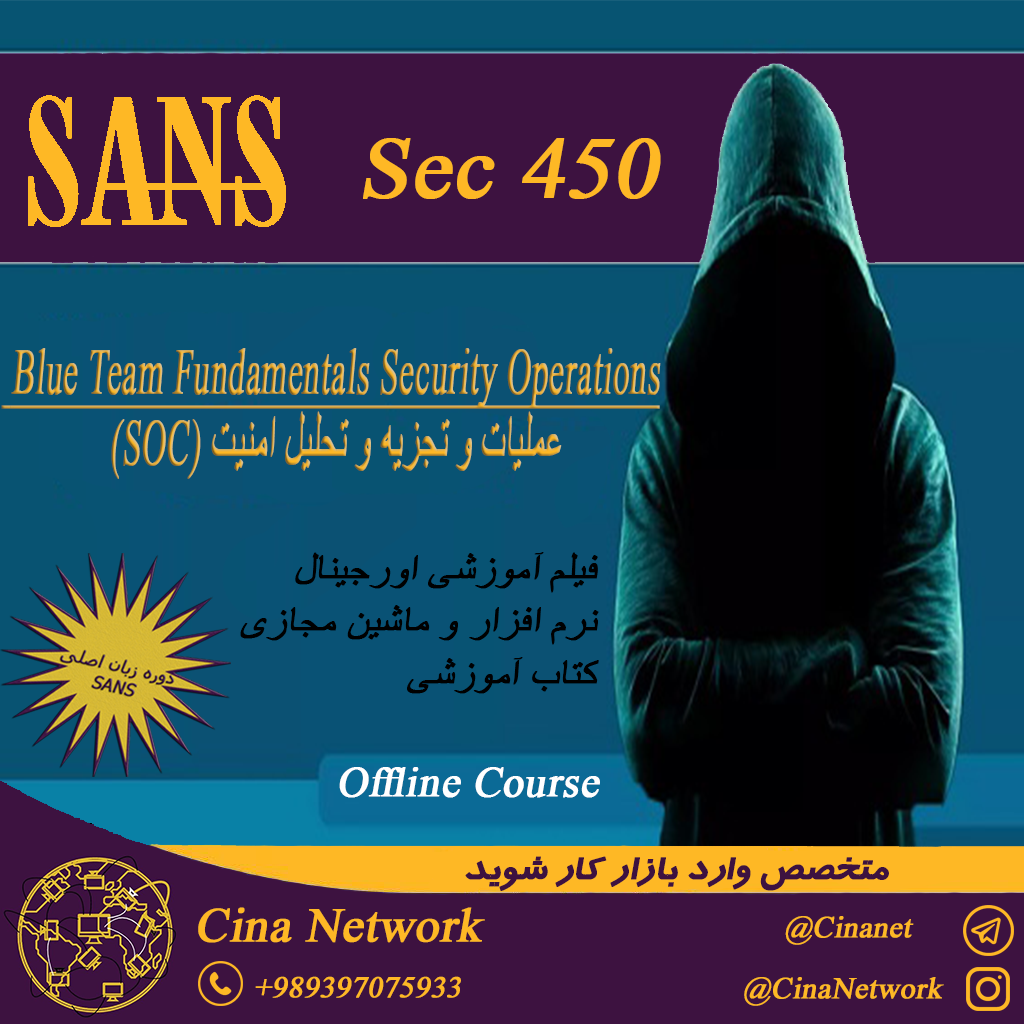نوع آموزش: آفلاین
عملیات و تحلیل امنیت | SANS Sec450: (SOC) Blue Team Fundamentals Security Operations and Analysis

پشتیبانی: تیکتینگ
ارائه مدرک: ندارد
زبان آموزش:
فارسی/ انگلیسی
(طبق توضیحات)
بازگشت وجه:
طبق قوانین سایت
قیمت
آیا سازمان شما به دنبال راهی سریع و موثر برای جذب تحلیلگران، مهندسان و معماران امنیتی جدید است؟ آیا مدیران مرکز عملیات امنیت شما نیاز به دید فنی بیشتر برای بهبود کیفیت تحلیلها، کمترکردن بار کاری و ادارهی بهینه و موثر هستند؟ یا شاید شما فردی هستید که به دنبال ورود به تیمهای امنیت سایبری یا شروع به کار به عنوان تحلیلگر SOC هستید؟ اگر جواب شما به هر کدام از این سوالات مثبت است، دوره SEC450، مبانی بلوتیم: عملیات و تحلیل امنیت دورهای ایدهآل برای شماست.
دوره SEC450 از موسسه SANS یک دوره سریع و فشرده برای اعضای جدید تیمهای امنیت سایبری و مدیران SOC است که به دنبال شروعی قدرتمند برای مسیر شغلی یا تربیت نیروهای مورد نیاز در داخل مجموعه خود هستند. این دوره ابزارهای رایج در محیط کاری یک کارشناس دفاع سایبری را به شما آموخته و تمام توضیحات لازم دربارهی ابزارها، فرایندها و جریان دادهای را که هر عضو تیم آبی باید به آنها مسلط باشد، در خود گنجانده است.
SANS SEC 450(Blue Team Fundemental)
SEC450.1: Blue Team Tools and Operations
Introduction to the Blue Team
What is a SOC? What is the mission?
Why are we being attacked?
Modern defense mindset
The challenges of SOC work
SOC Overview
The people, process, and technology of a SOC
Aligning the SOC with your organization
SOC functional component overview
Tiered vs. tierless SOCs
Important operational documents
Defensible Network Concepts
Understanding what it takes to be defensible
Network security monitoring (NSM) concepts
NSM event collection
NSM by network layer
Continuous security monitoring (CSM) concepts
CSM event collection
Monitoring sources overview
Data centralization
Events, Alerts, Anomalies, and Incidents
Event collection
Event log flow
Alert collection
Alert triage and log flow
Signatures vs. anomalies
Alert triage workflow and incident creation
Incident Management Systems
SOC data organization tools
Incident management systems options and features
Data flow in incident management systems
Case creation, alerts, observables, playbooks, and workflow
Case and alert naming convention
Incident categorization framework
Threat Intelligence Platforms
What is cyber threat intelligence?
Threat data vs. information vs. intelligence
Threat intel platform options, features, and workflow
Event creation, attributes, correlation, and sharing
SIEM
Benefits of data centralization
SIEM options and features
SIEM searching, visualizations, and dashboards
Use cases and use case databases
Automation and Orchestration
How SOAR works and benefits the SOC
Options and features
SOAR value-adds and API interaction
Data flow between SOAR and the SIEM, incident management system, and threat intelligence platform
Who Are Your Enemies?
Who’s attacking us and what do they want?
Opportunistic vs. targeted attackers
Hacktivists, insiders, organized crime, governments
Motivation by attacker group
Case studies of different attack groups
Attacker group naming conventions
SEC450.2: Understanding Your Network
Corporate Network Architecture
Routers and security
Zones and traffic flow
Switches and security
VLANs
Home firewall vs. corporate next-gen firewall capabilities
The logical vs. physical network
Points of visibility
Traffic capture
Network architecture design ideals
Zero-trust architecture and least-privilege ideals
Traffic Capture and Analysis
Network traffic capture formats
NetFlow
Layer 7 metadata collection
PCAP collection
Wireshark and Moloch
Understanding DNS
Name to IP mapping structure
DNS server and client types (stub resolvers, forwarding, caching, and authoritative servers)
Walkthrough of a recursive DNS resolution
Request types
Setting records via registrars and on your own server
A and AAAA records
PTR records and when they might fail
TXT records and their uses
CNAME records and their uses
MX records for mail
SRV records
NS records and glue records
DNS analysis and attacks
Detecting requests for malicious sites
Checking domain reputation, age, randomness, length, subdomains
Whois
Reverse DNS lookups and passive DNS
Shared hosting
Detecting DNS recon
Unauthorized DNS server use
Domain shadowing
DNS tunneling
DNS traffic flow and analysis
IDNs, punycode, and lookalike domains
New DNS standards (DNS over TLS, DNS over HTTPS, DNSSEC)
Understanding HTTP and HTTPS
Decoding URLs
HTTP communication between client and server
Browser interpretation of HTTP and REST APIs
GET, POST, and other methods
Request header analysis
Response header analysis
Response codes
The path to the Internet
REST APIs
WebSockets
HTTP/2 & HTTP/3
Analyzing HTTP for Suspicious Activity
HTTP attack and analysis approaches
Credential phishing
Reputation checking
Sandboxing
URL and domain OSINT
Header and content analysis
User-agent deconstruction
Cookies
Base64 encoding works and conversion
File extraction and analysis
High frequency GET/POST activity
Host headers and naked IP addresses
Exploit kits and malicious redirection
HTTPS and certificate inspection
SSL decryption – what you can do with/without it
TLS 1.3
How SMTP and Email Attacks Work
Email delivery infrastructure
SMTP Protocol
Reading email headers and source
Identifying spoofed email
Decoding attachments
How email spoofing works
How SPF works
How DKIM works
How DMARC works
Additional Important Protocols
SMB – versions and typical attacks
DHCP for defenders
ICMP and how it is abused
FTP and attacks
SSH and attacks
PowerShell remoting
SEC450.3: Understanding Endpoints, Logs, and Files
Endpoint Attack Tactics
Endpoint attack centricity
Initial exploitation
Service-side vs client-side exploits
Post-exploitation tactics, tools, and explanations – execution, persistence, discovery, privilege escalation, credential access, lateral movement, collection, exfiltration
Endpoint Defense In-Depth
Network scanning and software inventory
Vulnerability scanning and patching
Anti-exploitation
Whitelisting
Host intrusion prevention and detection systems
Host firewalls
File integrity monitoring
Privileged access workstations
Windows privileges and permissions
Endpoint detection and response tools (EDR)
File and drive encryption
Data loss prevention
User and entity behavior analytics (UEBA)
How Windows Logging Works
Channels, event IDs, and sources
XML format and event templates
Log collection path
Channels of interest for tactical data collection
How Linux Logging Works
Syslog log format
Syslog daemons
Syslog network protocol
Log collection path
Systemd journal
Additional command line auditing options
Application logging
Service vs. system logs
Interpreting Important Events
Windows and Linux login events
Process creation logs for Windows and Linux
Additional activity monitoring
Firewall events
Object and file auditing
Service creation and operation logging
New scheduled tasks
USB events
User creation and modification
Windows Defender events
PowerShell logging
Kerberos and Active Directory Events
Authentication and the ticket-granting service
Kerberos authentication steps
Kerberos log events in detail
Log Collection, Parsing, and Normalization
Logging pipeline and collection methods
Windows vs. Linux log agent collection options
Parsing unstructured vs. structured logs
SIEM-centric formats
Efficient searching in your SIEM
The role of parsing and log enrichment
Log normalization and categorization
Log storage and retention lifecycle
Files Contents and Identification
File contents at the byte level
How to identify a file by the bytes
Magic bytes
Nested files
Strings – uses, encoding options, and viewing
Identifying and Handling Suspicious Files
Safely handling suspicious files
Dangerous files types
Exploits vs. program “features“
Exploits vs. Payloads
Executables, scripts, office docs, RTFs, PDFs, and miscellaneous exploits
Hashing and signature verification
Signature inspection and safety of verified files
Inspection methods, detecting malicious scripts and other files
SEC450.4: Triage and Analysis
Alert Triage and Prioritization
Priority for triage
Spotting late-stage attacks
Attack lifecycle models
Spotting exfiltration and destruction attempts
Attempts to access sensitive users, hosts, and data
Targeted attack identification
Lower-priority alerts
Alert validation
Perception, Memory, and Investigation
The role of perception and memory in observation and analysis
Working within the limitations of short-term memory
Efficiently committing info to long-term memory
Decomposition and externalization techniques
The effects of experience on speed and creativity
Mental Models for Information Security
Network and file encapsulation
Cyber kill chain
Defense-in-depth
NIST cybersecurity framework
Incident response cycle
Threat intelligence levels, models, and uses
F3EAD
Diamond model
The OODA loop
Attack modeling, graph/list thinking, attack trees
Pyramid of pain
MITRE ATT&CK
Structured Analysis Techniques
Compensating for memory and perception issues via structured analysis
System 1 vs. System 2 thinking and battling tacit knowledge
Data-driven vs. concept-driven analysis
Structured analytic techniques
Idea generation and creativity, hypothesis development
Confirmation bias avoidance
Analysis of competing hypotheses
Diagnostic reasoning
Link analysis, event matrices
Analysis Questions and Tactics
Where to start – breaking down an investigation
Alert validation techniques
Sources of network and host information
Data extraction
OSINT sources
Data interpretation
Assessing strings, files, malware artifacts, email, links
Analysis OPSEC
OPSEC vs. your threat model
Traffic light protocol and intel sharing
Permissible action protocol
Common OPSEC failures and how to avoid them
Intrusion Discovery
Dwell time and intrusion type
Determining attacker motivation
Assessing business risk
Choosing an appropriate response
Reacting to opportunistic/targeted attacks
Common missteps in incident response
Incident Closing and Quality Review
Steps for closing incidents
Quality review and peer feedback
Analytical completeness checks
Closed case classification
Attribution
Maintaining quality over time
Premortem and challenge analysis
Peer review, red team, team A/B analysis, and structured self-critique
SEC450.5: Continuous Improvement, Analytics, and Automation
Improving Life in the SOC
Expectations vs. common reality
Burnout and stress avoidance
Improvement through SOC human capital theory
The role of automation, operational efficiency, and metrics in burnout
Other common SOC issues
Analytic Features and Enrichment
Goals of analytic creation
Log features and parsing
High-feature vs. low-feature logs
Improvement through SIEM enrichment
External tools and other enrichment sources
New Analytic Design, Testing, and Sharing
Tolerance to false positives/negatives
The false positive paradox
Types of analytics
Feature selection for analytics
Matching with threat intel
Regular expressions
Common matching and rule logic options
Analytic generalization and sharing with Sigma
Tuning and False Positive Reduction
Dealing with alerts and runaway alert queues
How many analysts should you have?
Types of poor alerts
Tuning strategy for poor alert types
Tuning via log field analysis
Using policy to raise fidelity
Sensitivity vs. specificity
Automation and fast lanes
Automation and Orchestration
The definition of automation vs. orchestration
What is SOAR?
SOAR product considerations
Common SOAR use cases
Enumeration and enrichment
Response actions
Alert and case management
The paradox of automation
DIY scripting
Improving Operational Efficiency and Workflow
Micro-automation
Form filling
Text expanders
Email templates
Smart keywords
Browser plugins
Text caching
JavaScript page modification
OS Scripting
Containing Identified Intrusions
Containment and analyst empowerment
Isolation options across network layers – physical, link, network, transport, application
DNS firewalls, HTTP blocking and containment, SMTP, Web Application Firewalls
Host-based containment tools
Skill and Career Development
Learning through conferences, capture-the-flag challenges, and podcasts
Home labs
Writing and public speaking
Techniques for mastery and continual progress
در این دوره دانشجویان مراحل عملیاتهای امنیت را خواهند آموخت: داده چگونه جمعآوری میشود، پس از جمعآوری در کجا ذخیره میشود، و چگونه از دل این دادهها تهدیدات شناسایی میشوند. دانشجویان در این دوره به طور عمیق وارد مبحث تاکتیکهای تریاژ و انجام تحقیقات روی رویدادهایی میشوند که به عنوان رویدادهای مخرب شناسایی شدهاند، و همچنین میآموزند که چگونه باید از اشتباهات رایج دوری کرده و همواره تحلیلهای امنیتی خود را با بالاترین کیفیت انجام دهند. دانشجویان نحوه کار و جزییات فنی عملکرد اکثر پروتکلهای پراستفاده را خواهند آموخت و مهارت لازم برای تشخیص فایلهای آسیبزا و همچنین حملات سایبری در هاستها و دادههای شبکهی تحت نظر خود را فرا خواهند گرفت. به طور خلاصه، برخی از مهمترین مباحثی که دانشجویان در این دوره خواهند آموخت عبارتند از:
- و نحوه اتصال و تعامل سیستم SIEM، بسترهای اطلاعات تهدید، سیستمهای مدیریت حادثه و سیستمهای اتوماسیون برای ایجاد یک جریان کاری روان و بیدردسر برای تحلیلگران
- تحلیل انواع رایج هشدار از جمله حملات مبتنی بر HTTP(S)، DNS و ایمیل
- تشخیص فعالیتهای مهاجم پس از اکسپلویت
- مدلهای ذهنی برای فهمیدن هشدارها و الگوهای حملات که میتوانند به اولویتبندی موثر هشدارها کمک کنند
- نحوه انجام تحلیل و تحقیقات با کیفیت بالا و بیطرفانه روی هشدارها
- نحوهی شناسایی پرخطرترین هشدارها، و راههای سریع برای تایید آنها
- نحوه جمعآوری لاگها در محیط و اهمیت قابلیت پارسینگ، غنیسازی و محاسبه همبستگی سیستم SIEM
- نحوه ایجاد و تنظیم استراتژیهای تحلیلی برای تشخیص تهدیدات، به منظور از بین بردن تشخیصهای مثبت کاذب
- کارشناسان امنیت سایبری
- کارشناسان تست نفوذ
- کارشناسان فارنزیک
- کارشناسان شبکه
- SANS Pentest Pack Level 1 یا CEH و یا PWK
حجم فایل ها
برای استفاده
قیمت


Reviews
There are no reviews yet.